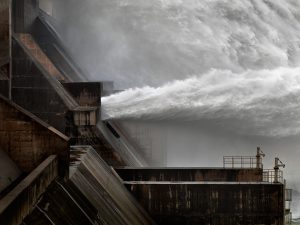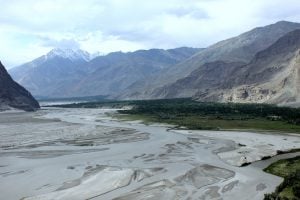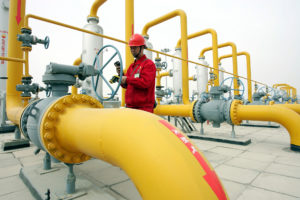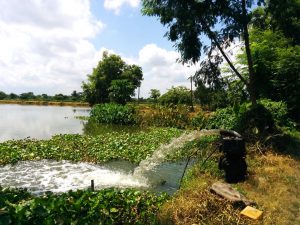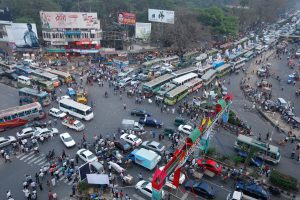After only six weeks of India’s annual 17-18 week summer monsoon, Uttarakhand is reeling under a series of flash floods that experts blame at least partly on the hydroelectric projects that had been started in the Himalayan state and then abandoned under a Supreme Court directive following the huge flash floods of 2013.
The other big cause is climate change, which has led to fewer rainy days this monsoon, but more intense rainfall on those days. Glaciers are also melting faster as the average temperature in the Himalayas has gone up thrice as much as the global average since 1990.
Faced with this double whammy of climate change impacts and abandoned partially-built dams that have channelled rivers in new directions, residents of many Uttarakhand villages are now stuck behind multiple landslides, with food running out and their homes in danger of being washed away or buried under yet another landslide.
![Mountain communities are cut off by floods and landslides [image by Dev Dutt Sharma / Mountain Partnership]](/wp-content/uploads/2016/07/Ganga-2.jpg)
- Due to flash floods and landslides, the highway to the popular pilgrim spot Badrinath was closed;
- The road to Nand Prayag had been closed for a fortnight – residents were running out of food and their homes were under constant threat because boulders on hillsides had come loose, while road construction material had not been removed either;
- Heavy rain was keeping everyone indoors in the famous hill station Mussorie, while the road from state capital Dehradun had been badly hit by landslides;
- A bus had been swept off the road by flash floods between Haldwani and Chorgalia – local residents risked their lives to pull out 24 passengers;
- Landslides at Gulab Ghati were slowing down traffic between Kathgodam and the other famous hill station Nainital;
- Eight houses were swept away by flash floods at Thailisain village, near the popular Dhari Devi temple; there were cracks on the road to the temple, while the bridge to it was at risk from an Alaknanda river in spate (Alaknanda is one of the principal tributaries of the Ganga in the Himalayas) – large trees had been uprooted and were rushing down the flooded river, battering the foundations of the bridge repeatedly;
- Landslides had made the roads to Gangotri and Yamunotri very risky – a group of visitors from Delhi had got out of their car to move some stones from a landslide-hit patch in Bhatwari on the way to Gangotri, when a boulder fell on their car and took it down the ravine; on the way to Yamunotri the weakened road collapsed under a fully-laden truck and all traffic was stuck for hours; on these roads, there have been two reported cases of landslides missing passing vehicles by a matter of a few metres;
- In almost all Uttarakhand towns including Dehradun, drains have not been desilted before the monsoon, so rainwater keeps flowing down the roads.
People suffer, ministries bicker
In such a situation, different ministries of the Government of India are quarrelling over the resumption of the stalled dams. The ministries of power and of environment, forests and climate change have told the Supreme Court that they want five of the hydroelectric projects resumed, while the ministry of water resources and Ganga rejuvenation has opposed any resumption.
The water resources ministry told the Supreme Court, “The three rivers, namely Alaknanda, Mandakini and Bhagirathi, and Ganga river from Dev Prayag downwards till Ganga Sagar should remain in their current condition without any further disruptions/interruptions or diversion.” Alaknanda, Mandakini and Bhagirathi together make up the Ganga before it descends from the Himalayas to the plains. Ganga Sagar is at the mouth of the Ganga, where it flows into the Bay of Bengal.
Officials in the water resources ministry told thethirdpole.net that the Prime Minister was keen to ensure “sufficient” water flow in the Ganga to dilute at least the worst of the pollution it suffers from further downstream.
But the power ministry is finalising a fresh hydropower policy to give a push to the sector that has been virtually halted due to opposition on the ground from people likely to be displaced by the projects. Environmentalists have also been opposing the projects, and the situation in Uttarakhand gives strength to their arguments.
There were 24 hydropower projects under construction in Uttarakhand when the 2013 floods hit the state, out of the 70 that have been planned for many years. Together, these 70 projects are supposed to generate 9,000 MW, but the water resources ministry has now pointed out to the Supreme Court that this potential has been bandied about without any consideration given to the carrying capacity of the rivers, the minimum water flow required to keep the rivers alive (the so-called environmental flow or e-flow) or the needs of local residents. The ministry now wants a cumulative impact study, taking all the proposed projects into account.
The five dams that the other ministries want to resurrect are the 300 MW Alaknanda project, 24.3 MW Bhyunder Ganga project, 4 MW Khirao Ganga project, 171 MW Lata Tapovan project and 195 MW Kotlibhel 1A project. The government has recommended “considerable design modifications” on the Alaknanda and Kotlibhel 1A projects.
Opposing this and pointing out that rejuvenating the Ganga was one of its mandates, the water resources ministry has told the Supreme Court, “If the origin of the Ganga is compromised, then the rejuvenation of the river will be impossible.”
The environment ministry had told the Supreme Court something similar in 2014 but has now changed tack. There are media reports that the change came after a meeting convened by the Prime Minister’s Office.
New law for Ganga
While the Supreme Court has to deal with the conflicting stances of various arms of the government, the water resources ministry is going ahead with a bill meant to help clean the Ganga. Minister Uma Bharti has said she has obtained support for the bill from the states through which the Ganga flows: Uttarakhand, Uttar Pradesh, Bihar, Jharkhand and West Bengal. This is essential because various aspects of water resources are central subjects, state subjects and concurrent subjects under the Indian Constitution.
Retired judge Girdhar Malviya, now member of the National Ganga River Basin Authority, will head a team to draft the bill.
The ministry needs to show results under the Prime Minister’s flagship National Mission for Clean Ganga, better known as Namami Gange – which is meant to clean the river, improve water flow and enable navigation by bigger vessels. The mission has an outlay of INR 20,000 crore (USD 2.98 billion) over five years, starting May 2015.
Bharti has been launching schemes in haste. She recently announced the simultaneous launch of 231 projects along the Ganga and its tributaries for modernisation and redevelopment of ghats (steps leading to and from the river) and crematoriums; development of sewage infrastructure and treatment; tree plantation; pilot and interceptor drains; trash skimmers; and conservation of biodiversity.
There are many more schemes, including:
- Four hundred villages along the Ganga to be developed as model villages, with 13 Indian Institutes of Technology adopting five villages each;
- Eight biodiversity centres to be developed at Rishikesh, Dehradun, Narora, Allahabad, Varanasi, Bhagalpur, Sahibganj and Barrackpore;Wildlife Institute of India has been asked to make a plan to conserve Gangetic dolphins, crocodiles and other species; the Central Inlands Fisheries Research Institute has been asked to improve fish stocks and variety;
- Of the 118 towns along the river, 59 have been surveyed and 27 reports prepared, mostly to improve sewage treatment;
- To control erosion, trees will be planted in 2,700 hectares along the river in the current financial year;
- Five automatic water quality monitoring stations have started functioning, in addition to 57 manual stations; the minister has promised 113 more automatic stations will be set up by next March;
- In Varanasi, the Prime Minister’s constituency, water quality data from automatic real-time sensors will be displayed at various ghats;
- As for industrial effluents flowing into the Ganga, the Central Pollution Control Board has set up monitoring stations in 508 factories, and has ordered 150 factories to shut down.
While this list may be impressive, its impacts remain to be seen, while the problem is of a different magnitude altogether.
![<p>Flash floods have been devastating Uttarakhand [image by Dev Dutt Sharma / Mountain Partnership]</p>](https://dialogue.earth/content/uploads/2016/07/Ganga-1-300x225.jpg)


